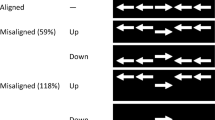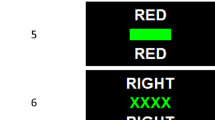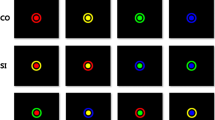Abstract
Non-informative, task-irrelevant auditory alerting signals often lead to increased interference effects in selective attention paradigms (e.g., Simon, Eriksen flanker). Some authors conclude that the alerting attentional network, activated by the alerting signal, reveals an inhibitory influence upon the executive attentional network, resulting in attenuated executive control. Alternatively, in the present study we argue that increased interference effects might be explained by alerting signals facilitating response activation processes (i.e., the activation of established S–R links). In a modified Eriksen-flanker paradigm, we contrasted these assumptions. We used word flanker stimuli for which S–R associations were established and word flanker stimuli without S–R associations. The presence of an alerting signal increased flanker compatibility only for flanker stimuli for which S–R associations existed while flanker compatibility effects were the same for all flanker types in conditions without alerting signals. Therefore, we conclude that alerting signals enhance stimulus triggered visuo-motor response activation processes.


Similar content being viewed by others
Notes
We thank an anonymous reviewer for suggesting this comparison.
It should be noted that there is a theoretical possibility to preserve the assumption that alerting signals negatively influence the executive control system. This, however, requires a number of additional assumptions. For example, one would have to assume that interference effects based on semantic analysis of the stimulus are less vulnerable to modulations by the reduced efficiency of the executive control system than interference effects based on S-R link processing. In consequence, however, this means that different stages of processing (e.g., semantic classification vs. response selection) are controlled by specialized executive control systems with specific susceptibilities to alerting signals. We thank an anonymous reviewer for mentioning this possibility.
References
Abrams, R. L., & Greenwald, A. G. (2000). Parts outweigh the whole (word) in unconscious analysis of meaning. Psychological Science, 11, 118–124.
Abrams, R. L., Klinger, M. R., & Greenwald, A. G. (2002). Subliminal words activate semantic categories (not automated motor responses). Psychonomic Bulletin and Review, 9, 100–106.
Bernstein, I. H., Rose, R., & Ashe, V. (1970). Preparatory state effects in intersensory facilitation. Psychonomic Science, 19, 113–114.
Böckler, A., Alpay, G., & Stürmer, B. (2011). Accessory stimuli affect the emergence of conflict, not conflict control: a Simon-task ERP study. Experimental Psychology, 58, 102–109.
Callejas, A., Lupiáñez, J., Funes, M. J., & Tudela, P. (2005). Modulations among the alerting, orienting and executive control networks. Experimental Brain Research, 167, 27–37.
Callejas, A., Lupiáñez, J., & Tudela, P. (2004). The three attentional networks: on their independence and interactions. Brain and Cognition, 54, 225–227.
Coles, M. G. H., Gratton, G., Bashore, T. R., Eriksen, C. W., & Donchin, E. (1985). A psychophysiological investigation of the continuous flow model of human information processing. Journal of Experimental Psychology Human Perception and Performance, 11, 529–553.
Correa, A., Lupiáñez, J., Madrid, E., & Tudela, P. (2006). Temporal attention enhances early visual processing: a review and new evidence from event-related potentials. Brain Research, 1076, 116–128.
Damian, M. F. (2001). Congruity effects evoked by subliminally presented primes: automaticity rather than semantic processing. Journal of Experimental Psychology Human Perception and Performance, 27, 154–165.
Dehaene, S., Naccache, L., Le Clec’h, G., Koechlin, E., Müller, M., Dehaene-Lambertz, G., et al. (1998). Imaging unconcious semantic priming. Nature, 395, 597–600.
Eriksen, C. W. (1995). The flanker task and response competition: a useful tool for investigating a variety of cognitive problems. Visual Cognition, 2, 101–118.
Eriksen, C. W., Coles, M. G. H., Morris, L. R., & O’Hara, W. P. (1985). An electromyographic examination of response competition. Bulletin of the Psychonomic Society, 23, 165–168.
Eriksen, B. A., & Eriksen, C. W. (1974). Effects of noise letters upon the identification of a target letter in a nonsearch task. Perception and Psychophysics, 16, 143–149.
Eriksen, C. W., & Schultz, D. W. (1979). Information processing in visual search: a continuous flow conception and experimental results. Perception and Psychophysics, 25, 249–263.
Fan, J., McCandliss, B. D., Sommer, T., Raz, A., & Posner, M. I. (2002). Testing the efficiency and independence of attentional networks. Journal of Cognitive Neuroscience, 14, 340–347.
Fenske, M. J., & Eastwood, J. D. (2003). Modulation of focused attention by faces expressing emotion: evidence from flanker tasks. Emotion, 3, 327–343.
Fischer, R., Plessow, F., & Kiesel, A. (2010). Auditory warning signals affect mechanisms of response selection: evidence from a Simon task. Experimental Psychology, 57, 89–97.
Fischer, R., & Schubert, T. (2008). Valence processing bypassing the response selection bottleneck? Evidence from the psychological refractory period paradigm. Experimental Psychology, 55, 203–211.
Fischer, R., Schubert, T., & Liepelt, R. (2007). Accessory stimuli modulate effects of non-conscious priming. Perception and Psychophysics, 69, 9–22.
Gratton, G., Coles, M. G. H., Sirevaag, E. J., Eriksen, C. W., & Donchin, E. (1988). Pre- and poststimulus activation of response channels: a psychological analysis. Journal of Experimental Psychology Human Perception and Performance, 14, 331–344.
Hackley, S. A., & Valle-Inclán, F. (1998). Automatic alerting does not speed late motoric processes in a reaction-time task. Nature, 391, 786–788.
Hackley, S. A., & Valle-Inclán, F. (1999). Accessory stimulus effects on response selection: does arousal speed decision making? Journal of Cognitive Neuroscience, 11, 321–329.
Hackley, S. A., & Valle-Inclán, F. (2003). Which stages of processing are speeded by a warning signal? Biological Psychology, 64, 27–45.
Heil, M., Osman, A., Wiegelmann, J., Rolke, B., & Hennighausen, E. (2000). N200 in the Eriksen-task: inhibitory executive processes? Journal of Psychophysiology, 14, 218–225.
Jepma, M., Wagenmakers, E. J., Band, G. P., & Nieuwenhuis, S. (2009). The effects of accessory stimuli on information processing: evidence from electrophysiology and a diffusion model analysis. Journal of Cognitive Neuroscience, 21, 847–864.
Kiesel, A., & Miller, J. (2007). Impact of contingency manipulations on accessory stimulus effects. Perception and Psychophysics, 69, 1117–1125.
Kiesel, A., Wendt, M., & Peters, A. (2007). Task switching: on the origins of response congruency effects. Psychological Research, 71, 117–125.
Leuthold, H., Sommer, W., & Ulrich, R. (1996). Partial advance information and response preparation: Inferences from the lateralized readiness potential. Journal of Experimental Psychology General, 125, 307–323.
Logan, G. D. (1988). Toward an instance theory of automatization. Psychological Review, 95, 492–527.
Logan, G. D., & Gordon, R. D. (2001). Executive control of visual attention in dual-task situations. Psychological Review, 108, 393–434.
Low, K. A., Larson, S. L., Burke, J., & Hackley, S. A. (1996). Alerting effects on choice reaction time and the photic eyeblink reflex. Electroencephalography and Clinical Neurophysiology, 98, 385–393.
Magen, H., & Cohen, A. (2002). Action-based and vision-based selection of input: two sources of control. Psychological Research, 66(4), 247–259.
Mattler, U. (2005). Flanker effects on motor output and the late-level response activation hypothesis. Quarterly Journal of Experimental Psychology A, 58, 577–601.
Miller, J., & Hackley, S. A. (1992). Electrophysiological evidence for temporal overlap among contingent mental processes. Journal of Experimental Psychology General, 121, 195–209.
Müller-Gethmann, H., Ulrich, R., & Rinkenauer, G. (2003). Locus of the effect of temporal preparation: evidence from the lateralized readiness potential. Psychophysiology, 40, 597–611.
Neumann, O., & Klotz, W. (1994). Motor responses to non-reportable masked stimuli: where is the limit of direct motor specification? In C. Umiltá & M. Moscovitch (Eds.), Attention and performance XV (pp. 123–150). Cambridge: MIT Press.
Niemi, P., & Näätänen, R. (1981). Foreperiod and simple reaction time. Psychological Bulletin, 89, 133–162.
Osman, A., & Moore, C. M. (1993). The locus of dual-task interference: psychological refractory effects on movement-related brain potentials. Journal of Experimental Psychology Human Perception and Performance, 19, 1292–1312.
Osman, A., Moore, C. M., & Ulrich, R. (1995). Bisecting RT with lateralized readiness potentials: precue effects after LRP onset. Acta Psychologica, 90, 111–127.
Posner, M. I. (1978). Chronometric explorations of mind. Hillsdale: Earlbaum.
Posner, M. I., & Boies, S. J. (1971). Components of attention. Psychological Review, 78, 391–408.
Posner, M. I., & Petersen, S. E. (1990). The attention system of the human brain. Annual Review Neuroscience, 13, 25–42.
Ratcliff, R., & McKoon, G. (1988). A retrieval theory of priming in memory. Psychological Review, 95, 385–408.
Raz, A., & Buhle, J. (2006). Typologies of attentional networks. Nature Review Neuroscience, 7, 367–379.
Rolke, B., & Hofmann, P. (2007). Temporal uncertainty degrades perceptual processing. Psychonomic Bulletin and Review, 14, 522–526.
Sanders, A. F., & Lamers, J. M. (2002). The Eriksen-flanker effect revisited. Acta Psychologica, 109(1), 41–56.
Shaffer, W. O., & LaBerge, D. (1979). Automatic semantic processing of unattended words. Journal of Verbal Learning and Verbal Behavior, 18(4), 413–426.
Simon, J. R. (1990). The effects of an irrelevant directional cue on human information processing. In R. W. Proctor & T. G. Reeve (Eds.), Stimulus–response compatibility (pp. 31–86). Amsterdam: Elsevier.
Stahl, J., & Rammsayer, T. H. (2005). Accessory stimulation in the time course of visuomotor information processing: stimulus intensity effects on reaction time and response force. Acta Psychologica, 120, 1–18.
Stoffels, E. J., van der Molen, M. W., & Keuss, P. J. G. (1985). Intersensory facilitation and inhibition: Immediate arousal and location effects of auditory noise on visual choice reaction time. Acta Psychologica, 58, 45–62.
Stürmer, B., Leuthold, H., Soetens, E., Schröter, H., & Sommer, W. (2002). Control over location-based response activation in the Simon task: Behaviorial and electrophysiological evidence. Journal of Experimental Psychology Human Perception and Performance, 28, 1345–1363.
Ulrich, R., & Mattes, S. (1996). Does immediate arousal enhance response force in simple reaction time? Quarterly Journal of Experimental Psychology A, 49, 972–990.
Vorberg, D., Mattler, U., Heinecke, A., Schmidt, T., & Schwarzbach, J. (2003). Different time courses for visual perception and action priming. PNAS, 100, 6275–6280.
Waszak, F., & Hommel, B. (2007). The costs and benefits of cross-task priming. Memory and Cognition, 35(5), 1175–1186.
Wendt, M., & Kiesel, A. (2008). The impact of stimulus-specific practice and task instructions on response congruency effects between tasks. Psychological Research, 72, 425–432.
Acknowledgments
This research was supported by a grant of the German Research Foundation (DFG, FI 1624/2-1). We thank Susann Schade for assistance in data collection.
Author information
Authors and Affiliations
Corresponding author
Rights and permissions
About this article
Cite this article
Fischer, R., Plessow, F. & Kiesel, A. The effects of alerting signals in action control: activation of S–R associations or inhibition of executive control processes?. Psychological Research 76, 317–328 (2012). https://doi.org/10.1007/s00426-011-0350-7
Received:
Accepted:
Published:
Issue Date:
DOI: https://doi.org/10.1007/s00426-011-0350-7




